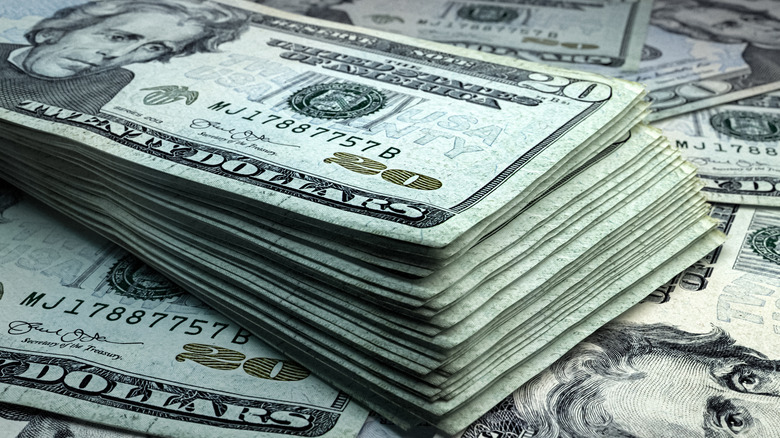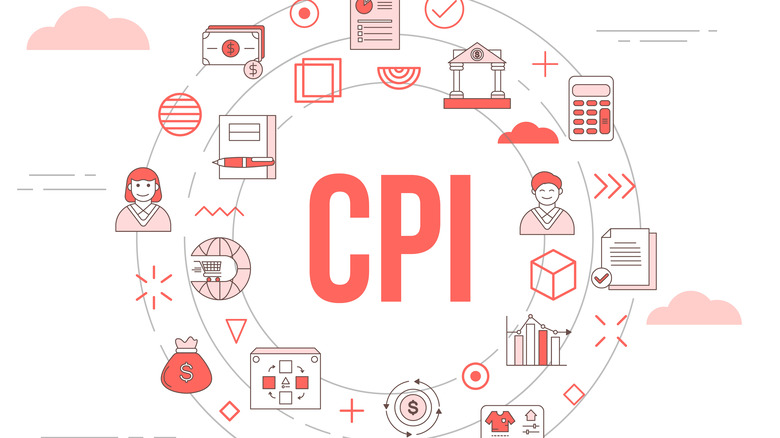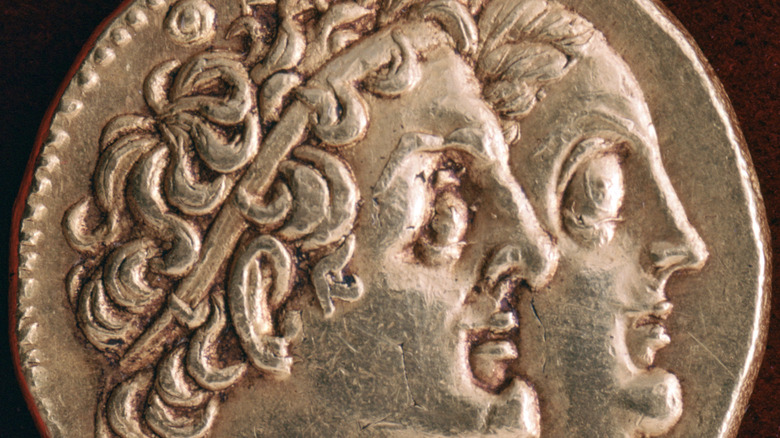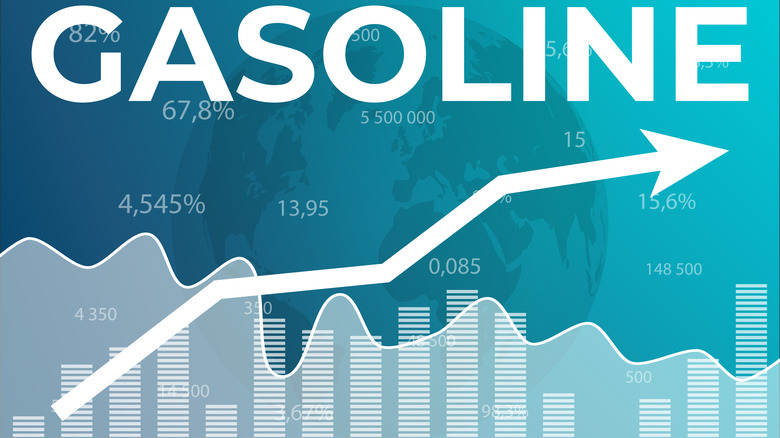Do Prices Ever Go Back Down After Inflation?
In June 2022, inflation peaked at a historic 40-year high, placing a great deal of financial burden on American workers far and wide (via Politico). Ethnic minorities and low-income earners felt the financial pinch more than others, but it's safe to say that inflation gripped the vast majority of U.S. residents. CNBC reports that over the course of 2022, grocery prices surged 13.5%, which, incidentally, is the highest hike since 1979. Food, housing, clothing, utilities, and medical services all rose to the utmost degree. People huddled around gas pumps gasping as fuel prices shot up almost 50% in a single year(per CNBC). Millennials were priced out of the housing market (via Marketplace) and forced into apartments where astronomical rental rates are becoming the norm (per Time).
Like a long line spiraled around a self-checkout station at the local superstore, we are all trying to peak around the corner, silently asking, "When will it end?" "When" is the operative word here, but perhaps a better question could be posed by removing that word entirely: "Will it end? Do prices ever go back down after inflation?"
Inflation in brief
Inflation is defined as "a continuing rise in the general price level," according to Merriam-Webster. The topic is easy enough to understand — prices go up, and purchasing power goes down. This translates to an increase in the consumer price index, or CPI for short, which measures consumer price changes across both time and location to determine the power of a currency (via the U.S. Bureau of Labor Statistics). However, the logistics of such a scenario are a lot more complicated than they initially appear.
For starters, Investopedia reports that there are three distinct classifications of inflation. Namely, they are cost-push inflation, which takes place when the price of production goes up so high that it decreases aggregate supply (via Investopedia); built-in inflation, created when corporations dispense wage increases while trying to maintain their previous profit margins and must increase their prices to compensate for the balance (per Forbes); and demand-pull inflation, which means prices skyrocket due to sheer lack of supply.
Depending on the underlying cause and aftermath of inflation, the economic implications might be positive, negative, or both. Generally, though, inflation is perceived as bad, particularly if it is rapidly escalating.
Inflation has existed since ancient times
While you might consider the concept of inflation modern, Oxford Classical Dictionary reports that it has a long and harrowed history, dating all the way back to the ancient world. According to DailyHistory.org, one of the most prominent examples of pre-modern inflation occurred in ancient Egypt during the second century B.C. when the currency was devalued under the rule of King Ptolemy IV. At the time, the country was grappling with a war-stricken economy that hovered in the shadows of the Fourth Syrian War. Wrongly assuming that paying off war debts was as simple as changing currencies, the fourth pharaoh of Ptolemaic Egypt swiftly switched over from the silver drachma, which was in circulation to the lesser-valued copper drachma.
World History Encyclopedia reports that when King Ptolemy IV changed the weight of the bronze coins in circulation, their value was cut in half, which adversely affected purchasing power, hitting rural laborers the hardest because they were often paid in bronze. Much of this era is shrouded in confusion, but Oxford Classical Dictionary goes on to say that "prices across a range of commodities suddenly and permanently surged by roughly tenfold."
As you can see by this example, prices didn't go back down. Even as the coins changed hands and power shifted, the ancient Egyptian monetary system remained in a perpetual state of disrepair.
Inflation might have contributed to the fall of Rome
You may have heard the expression "worth your weight in gold," which, according to Dictionary.org, dates back to the Romans. DailyHistory.org reports that in Rome's early monetary system, coinage — which came mostly in the form of copper, bronze, and silver (i.e., not gold) — was literally worth its weight. For centuries, the economy flourished, exhibiting an economic gold standard that included low taxes and low to non-existent rates of inflation.
Just as the Roman Empire claimed its spot as a global economic powerhouse, however, a recession hit, and A.D. 200 marks the year the Romans experienced built-in inflation for the very first time (per DailyHistory.org). Like the empire itself, in the wake of the Antonine plague, the consumer price index rose. This was largely attributed to the death of workers from the plague, which dramatically increased the median wage. Employers bent on maintaining those precious profit margins increased the price of goods to make up the difference, and consumers took a serious financial hit.
In an effort to combat the economic nosedive, Roman coins were swapped out for lower-quality bronze coins. Mayhem ensued in the form of hyperinflation so drastic that some historians attribute it to Rome's untimely collapse (via Bitcoin Magazine). In other words, no, the prices did not fall. Rather, the entire empire did.
Inflation in U.S. history
Did you know there was a period of record-high inflation that marred the second half of the 20th century (via Federal Reserve History)? According to NPR, this era, known as "The Great Inflation," lasted from 1965 to 1981, with inflation rates peaking at 13%. While it didn't signal an empire's fall, it gave way to the collapse of the Bretton Woods System, which previously meant the U.S. dollar was backed by gold (via Investopedia).
Fearing the U.S. gold supply could no longer sustain the amount of paper money in circulation at that time, President Richard Nixon removed the gold backing, devaluing the dollar bill in the process. While the move was intended to be a temporary measure, it ultimately became the downfall of the entire system, which encompassed 44 countries across the globe. The White House draws historical parallels to this event and the current inflation but notes that the inflationary period that took place after World War II is most comparable to the modern scenario.
According to the U.S. government, there have been six major inflationary episodes throughout American history. The episode they claim was most comparable to today's inflation took place after World War II and did end in lower prices. But before you get too excited, that wasn't a good thing, as these lower prices sent the nation into a mild recession.
Economists project some prices will go back down and others won't
According to Vox, inflation has been trending down since June 2022. Prices at the pump are in decline, fueled by the reopening of West Coast refineries (via CNN). Yet, even with a significant decrease, they're still about $1 more than last year. In a candid interview with Vox reporters, Bank of America's Michael Gapen explained. "Will prices go back to where they were in a pre-pandemic sense? Probably not. But is there room for some prices to fall fairly dramatically in the direction of where they were in the pre-pandemic era? I think the answer to that is yes."
CNBC reports that the end is unclear, with some experts claiming prices may level out by 2023. On the flip side of that coin is Time, whose analysts project that inflation is here to stay, citing low employment as a seemingly unsolvable root cause. What's important to note is that returning to pre-pandemic price levels is not necessarily the goal either way. Most experts are more concerned with stabilizing the inflation rate of the market economy and keeping it somewhere between 1.5% and 2%.





